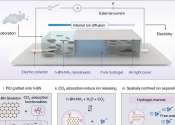Digital Tattoo for Moto X offered in packs of ten
Back in 2013, Regina Dugan, the former DARPA head, and leading special projects for the Google-owned Motorola, showed electronic tattoos as one password authentication sign of the future.
Consumer & Gadgets

Back in 2013, Regina Dugan, the former DARPA head, and leading special projects for the Google-owned Motorola, showed electronic tattoos as one password authentication sign of the future.
Energy & Green Tech

Researchers at WMG at the University of Warwick have found that use of inductive charging, whilst highly convenient, risks depleting the life of mobile phones using typical LIBs (Lithium-ion batteries)
Jun 26, 2019
0
2
Software

One billion Android phones are at risk of attacks by hackers taking advantage of what a research firm says are 400 vulnerabilities detected on the smartphone's chips.
Electronics & Semiconductors

University of Queensland researchers have built a generator that absorbs carbon dioxide (CO2) to make electricity.
Apr 18, 2024
2
149
Telecom

Sunshine streaming through a window could be directly harnessed for wireless data transmission to electronic devices. KAUST researchers have designed a smart glass system that can modulate the sunlight passing through it, ...
Nov 1, 2022
0
738
Consumer & Gadgets

A team at LG Chem has announced on LG's News Room webpage that the company has developed a new kind of foldable screen display technology for use in mobile devices. As part of the announcement, officials at LG claim that ...
Computer Sciences

Ultrasonic waves don't make a sound, but they can still activate Siri on your cellphone and have it make calls, take images or read the contents of a text to a stranger. All without the phone owner's knowledge.
Feb 27, 2020
2
259
Electronics & Semiconductors

Rechargeable batteries are at the heart of many new technologies involving, for example, the increased use of renewable energies. More specifically, they are employed to power electric vehicles, cell phones, and laptops. ...
May 7, 2020
0
256
Internet

A security firm handling employee fingerprint identification for companies worldwide has exposed more than 2 million bits of data, including 76,000 fingerprints, according to a cyberthreat research group.
Consumer & Gadgets

Fresh off its recent augmented reality (AR) kick, Facebook Labs has revealed plans to curate this AI software for wearable devices. Projected as a shorter-term goal than the previously announced AR glasses, this wrist-based ...
The telephone (from the Greek: τῆλε, tēle, "far" and φωνή, phōnē, "voice") is a telecommunications device that transmits and receives sound, most commonly the human voice. It is one of the most common household appliances in the developed world, and has long been considered indispensable to business, industry and government. The word "telephone" has been adapted to many languages and is widely recognized around the world.
The device operates principally by converting sound waves into electrical signals, and electrical signals into sound waves. Such signals when conveyed through telephone networks — and often converted to electronic and/or optical signals — enable nearly every telephone user to communicate with nearly every other worldwide. Graphic symbols used to designate telephone service or phone-related information in print, signage, and other media include ℡, ☎, ☏, and ✆.
This text uses material from Wikipedia, licensed under CC BY-SA